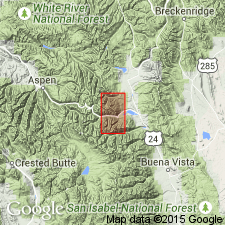
- Usage in publication:
-
- Red Mountain rhyolite
- Modifications:
-
- Original reference
- Dominant lithology:
-
- Rhyolite
- AAPG geologic province:
-
- Eagle basin
Summary:
Red Mountain rhyolite. Light-gray to white siliceous rhyolite containing finely disseminated pyrite, which on weathering produces red iron oxide, the material which is responsible for the brilliant coloring of Red Mountain, Chaffee County, central Colorado. Has two rather distinct phases --the normal or massive phase and a brecciated form. Is certainly older than Grizzly Peak rhyolite, which is believed to be of Tertiary (Eocene?) age, and appears to be younger than late Cretaceous porphyry dikes, so it is certainly post-Cretaceous [Tertiary].
[Recognized in Bonanza-Monarch-Tomichi-Pitkin region, central CO.]
Source: US geologic names lexicon (USGS Bull. 896, p. 1786).
- Usage in publication:
-
- Red Mountain rhyolite†
- Modifications:
-
- Abandoned
- AAPG geologic province:
-
- Eagle basin
Stark, J.T., and Barnes, F.F., 1935, Geology of the Sawatch Range, Colorado: Colorado Scientific Society Proceedings, v. 13, no. 8, p. 467-479, (incl. geologic map)
Summary:
Pg. 477, map. †Red Mountain rhyolite discarded. Included, along with Howell's †Grizzly Peak rhyolite, in their Grizzly Mountain rhyolite.
[These rocks are now included in Grizzly Peak Tuff (see entry under Fridrich and others, 1991).]
Source: US geologic names lexicon (USGS Bull. 896, Grizzly Mountain entry p. 882).
For more information, please contact Nancy Stamm, Geologic Names Committee Secretary.
Asterisk (*) indicates published by U.S. Geological Survey authors.
"No current usage" (†) implies that a name has been abandoned or has fallen into disuse. Former usage and, if known, replacement name given in parentheses ( ).
Slash (/) indicates name conflicts with nomenclatural guidelines (CSN, 1933; ACSN, 1961, 1970; NACSN, 1983, 2005, 2021). May be explained within brackets ([ ]).

